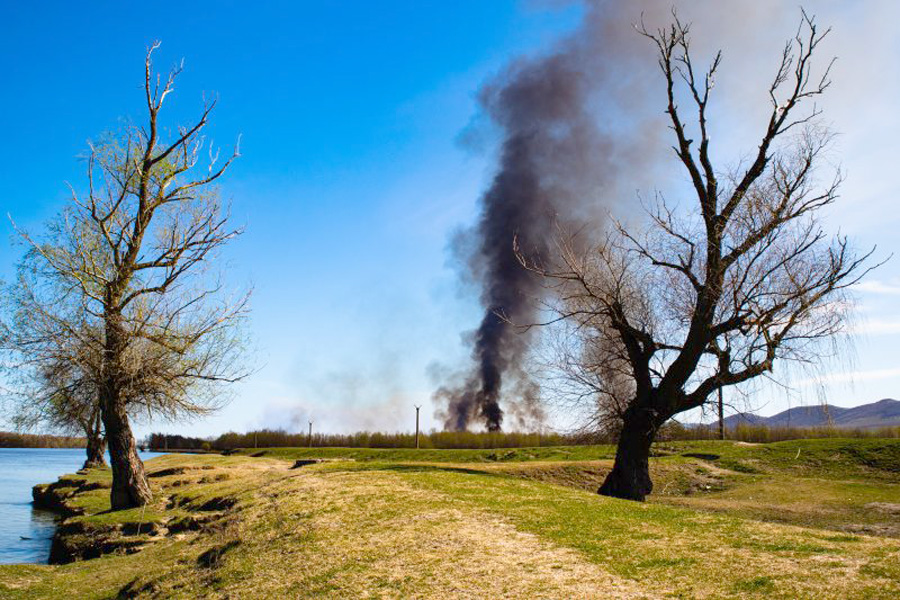How the Danube Delta got on the fire map of Europe
Redazione di TheBlackCoffee
To regenerate and use the land, people in Romania’s Danube Delta burn the vegetation. This practice becomes problematic when it occurs outside the regular season. Right now, Romania is responsible for almost half of all fires in protected areas in Europe.
6-7 February 2023, 150 hectares; 21 February 2023, 20 hectares; 25 February 2023, 110 hectares; 20 March 2023, 20 hectares; 24 March 2023, 15 hectares.
These figures show just some of the wildfires since the beginning of the year in the Danube river delta. This river delta is a biosphere reserve, a wetland of international importance, a natural and world heritage site and a Natura 2000 site. The total area concerned by fires is even larger, and hard to calculate.
A satellite view from the European Forest Fire Information System shows a colorful delta. Green, however, does not indicate reeds, but burnt areas. A 2020 European report shows that Romania is responsible for almost half of all fires in protected areas in Europe, merely due to fires in this delta.

Why are people burning vegetation in the Danube delta? We went there to try to understand.
According to EFFIS, the European Forest Fire Information System, in 2022 more than 55,000 hectares were affected by bushfires.
Due to climate change and agricultural practices, bushfires are increasing in Romania. A European Commission report shows that in 2020 Romania was the worst affected country in the EU, followed by Portugal, Spain and Italy. In both 2019 and 2020, Romania accounted for half of the burnt area inside Natura 2000 sites. This was mainly because of the Danube river delta, which covers around 70,000 hectares.
In 2021, more than 15,000 hectares of Romania’s Natura 2000 sites went up in flames. By comparison, despite a proportionately high number of fires overall, only 10,000 hectares of Greece’s protected sites burned.
In 2022, the number of forest fires in Romania increased 7-fold year on year: 711 were recorded in the first half of the year compared to 98 in the same period of 2021. On 25-27 March 2022 alone, almost 1,400 vegetation fires were reported throughout Romania. By the beginning of April 2022, 5 people had died.
In this series we want to discuss, in depth, the answers to the question: why is Romania burning and what can be done about it?
Sfântu Gheorghe is the oldest branch of the Danube. Near where the river empties into the Black Sea is a township of the same name. It is part of the . The 560 or so inhabitants can only be reached by boat, a journey of over an hour.
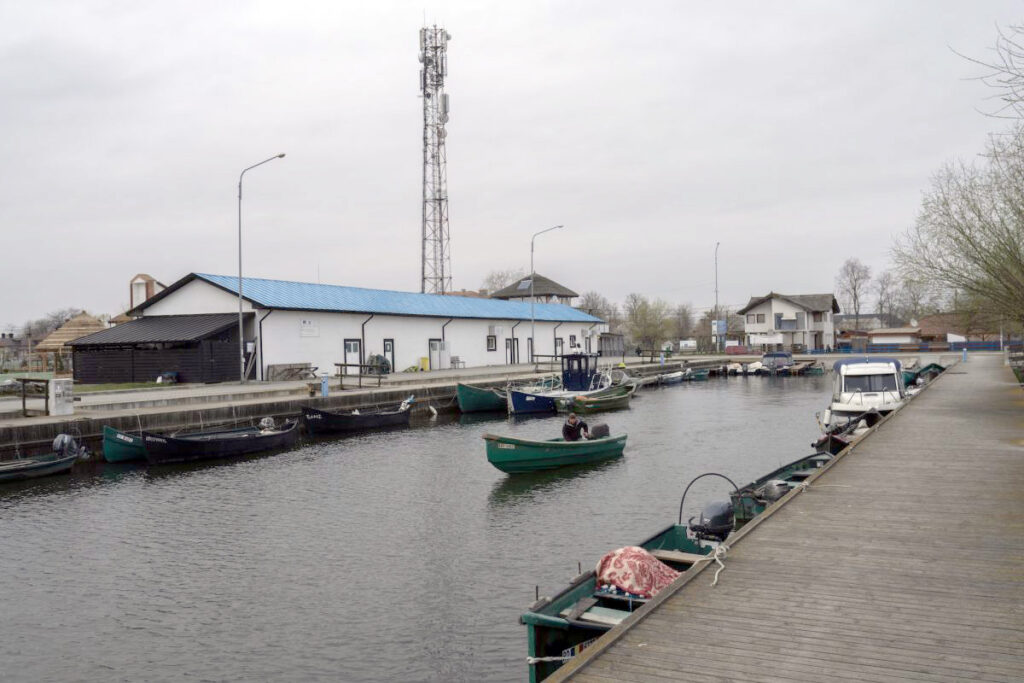
Photo: Andreea Câmpeanu
Once back on dry land, you come across a village of simple organisation: street I, with the town hall, the police station, the cultural centre and, for some time now, a museum; and street II, where the school is. On either side of the unpaved road are houses. Some have reed roofs, some have tile roofs, some have solar panels.
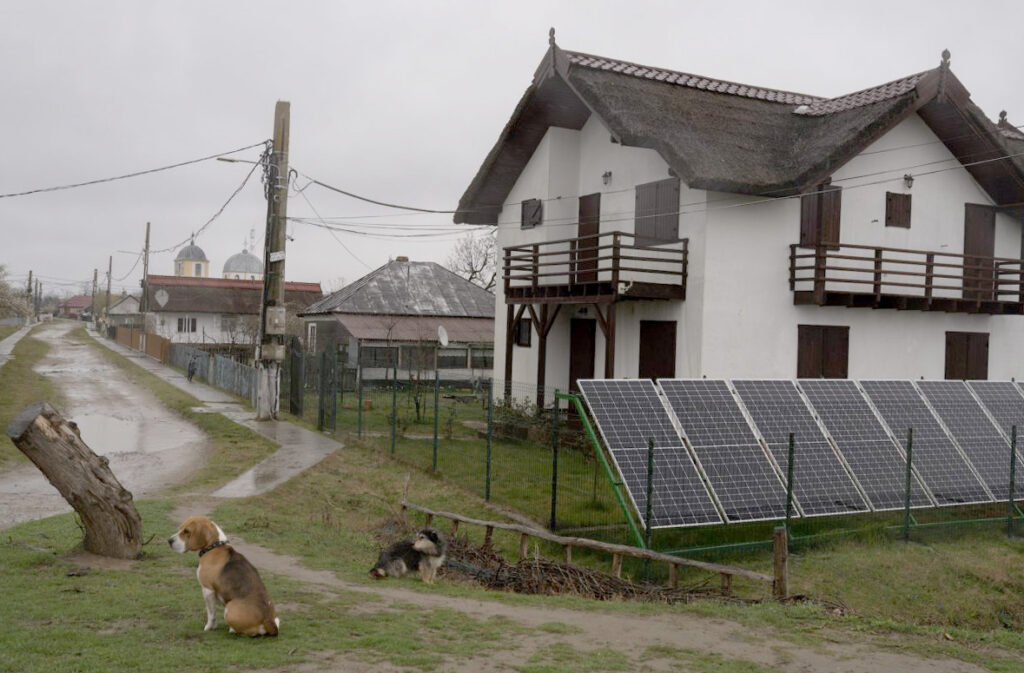
One of the main streets in Sfântu Gheorghe. The mayor, Valentin Sidorencu, once wanted to build a park with photovoltaic panels on a pasture, some 7 km away from the village, where there was nothing. The authorities blocked this on the grounds that it would change the image of the Danube Delta. But they allowed the panels to be placed on houses.
The Danube Delta Biosphere Reserve Administration has been in charge of the reserve’s management since 1993. According to its data, in the first three months of this year there were 27 bushfires in the Danube delta. Three of them were in strictly protected areas where, by law, economic activity is forbidden and entry is restricted to research or patrols. There are twenty such areas in the reserve, almost half of them in the Sfântu Gheorghe sector. They tells us that between 2020 and 2023, 38’777.9 hectares have been affected by fires.

Extract from the response received by PressOne from the Danube Delta Biosphere Reserve Administration. In 2020 and 2022 alone, more than 35,000 hectares were burned in the Danube Delta Biosphere Reserve.
Laura Efimov welcomes tourists and cooks fresh fish for them, caught by her husband, Nicu Efimov. Laura works in the summer in order to provide for the winter: «I have to pay for my utilities all winter. I’ve been saving my money since the summer. I paid the last instalments [of bills] using what I earned in the summer. I didn’t even borrow. After that, I start saving again» – says Laura Efimov.
Using EFFIS data, the situation in the Sfântu Gheorghe area is clear: in the period 2020-2023, satellites recorded over 40,000 hectares affected by fires. The total area of the municipality is just over 62,000 hectares.
According to the “Delta” emergency inspectorate of Tulcea County, 99% of the fires in the period 2020-2023 were caused by anthropogenic factors (that is, by people). The perpetrators were not identified. Moreover, most of the fires were located in hard-to-reach areas. According to locals, “fires were set in a mud patch”, i.e. on an area of water where reeds or other vegetation grows.
“We have a commercial fishing area that we get to by helicopter”
Nicu Efimov has lived in Sfântu Gheorghe for most of his life. He is a commercial fisherman with his son Mirel. When not fishing, he takes tourists out boating. He is used to the ups and downs that come with living in the delta, but he’s keen to change “crooked legislation”– as he calls it.
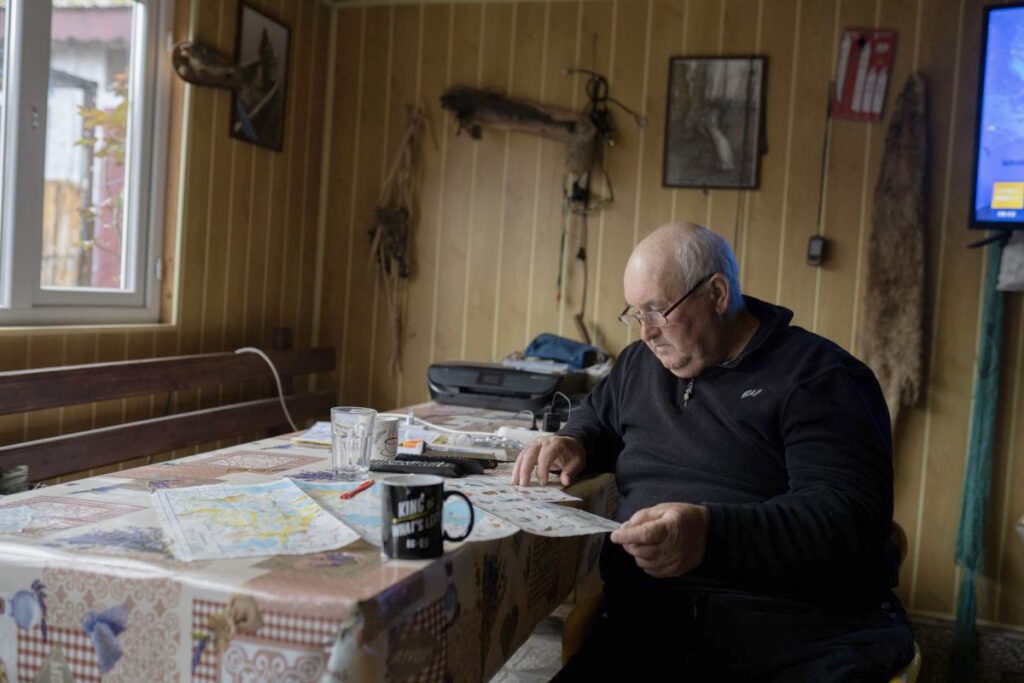
Photo: Andreea Câmpeanu
«We currently have a commercial area that, to be legal, we would have to reach by helicopter. Because one access channel is in a strictly protected area, and 3 km of another channel is again a strictly protected area. So how do we get there?»
«The commercial area is not marked either. When I drop the nets, I go by the landmarks. I can also cross the site and enter the strictly protected area. And then you can be told that you’re a poacher, that you’ve gone two metres into the strictly protected area»– Nicu says.

Photo: Andreea Câmpeanu
Moreover, there are no legal tourist boat routes in Sfântu Gheorghe.
«It is done tacitly. You take a channel of the strictly protected area. There is a tacit thing like a tourist route, but legally we shouldn’t be there. We have asked for a corridor along the shoreline to the commercial area. This way there is also a legal tourist route» – adds Nicu Efimov.
Tacitly, the vegetation is also being burned. Despite the fact that legislation prohibits the use of fire to clear land, people in the delta still do it.
«Vegetation is set on fire to clear the land. Whether or not [the land] is used, it’s done for regeneration. Since the old days, they burn. The only problem is that there are some who go out and light it when they shouldn’t. But sanitation has to be done» – Nicu believes.
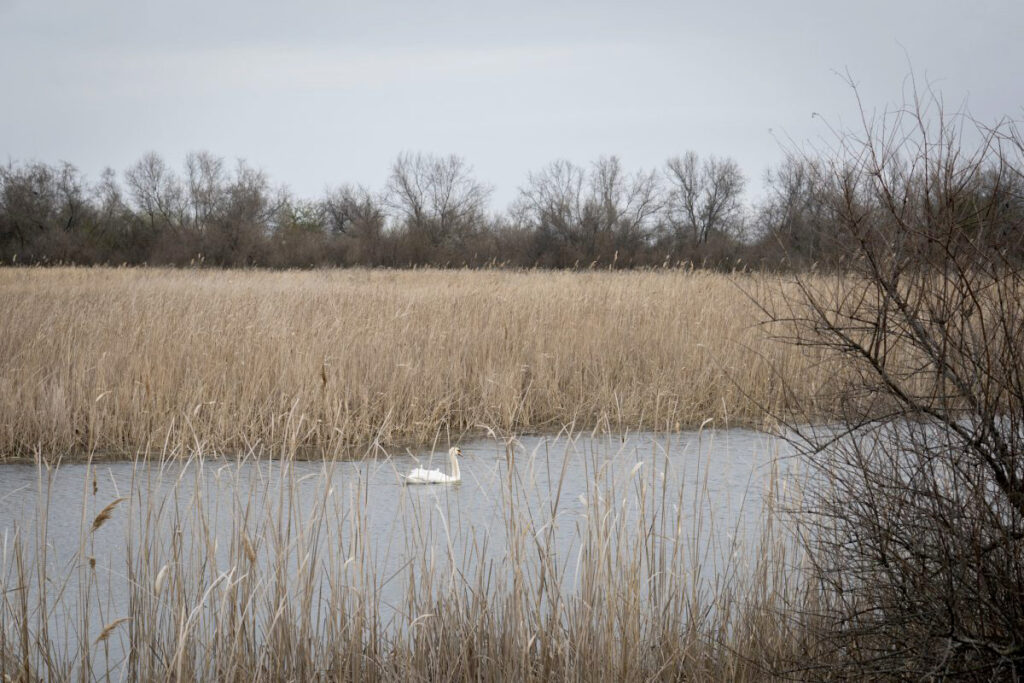
Photo: Andreea Câmpeanu
Reeds are a resource for all local inhabitants. It can be given to animals as food, used in construction or roofing, or turned into pellets. Locals explain that when it comes to burning, it works like this: to have fresh reeds in spring, you need to get rid of the old ones in winter. So from December to February, when the birds are not nesting and the animals have left, they set fire to the previous year’s growth.
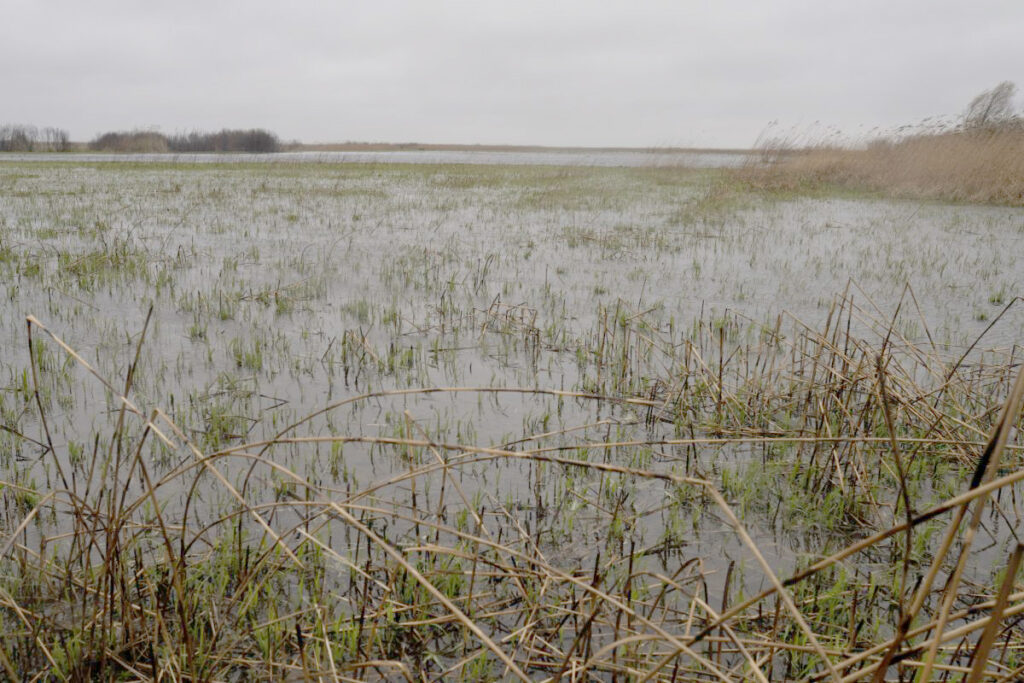
Photo: Andreea Câmpeanu
There are no alternatives, says Nicu Efimov. You cannot harvest by hand, because the water in the pond needs to freeze and the reeds need to be dry to be harvested. Nor can they be harvested mechanically, as there is a risk of destroying the roots and the plant will not grow the following year. And the biggest problem is the size of the area: “How else can you clear thousands of hectares?”
People say old reeds are a hindrance to fishing and grazing
Old reeds need to be removed for multiple reasons, agrees the mayor of Sfântu Gheorghe. After two or three years, they reach a height of over two metres and fall down.
«It becomes like a carpet of vegetation that doesn’t rot (…) It doesn’t allow plants to live, nor does it allow living things to nest there. If I leave that area, in five years a 20-centimetre carpet of vegetation is deposited and no more fish can enter»– says Mayor Valentin Sidorencu.

Photo: Andreea Câmpeanu
The clearances are widely believed to be necessary for fishing, on which most locals live.
«It is to have clean water, not to have impediments to enter an area. Fish look for the right water temperature. And the water warms up faster when i is shallow» – explains Nicu Efimov, a fisherman in Sfântu Gheorghe.
For many people in the delta, another source of income is cattle farming. But grazing is only possible in a few areas, known as “grinduri”. Their elevation varies according to the water level and they are always at risk of flooding. As a result, cattle farmers are blamed for burning vegetation to expand their small grazing areas.
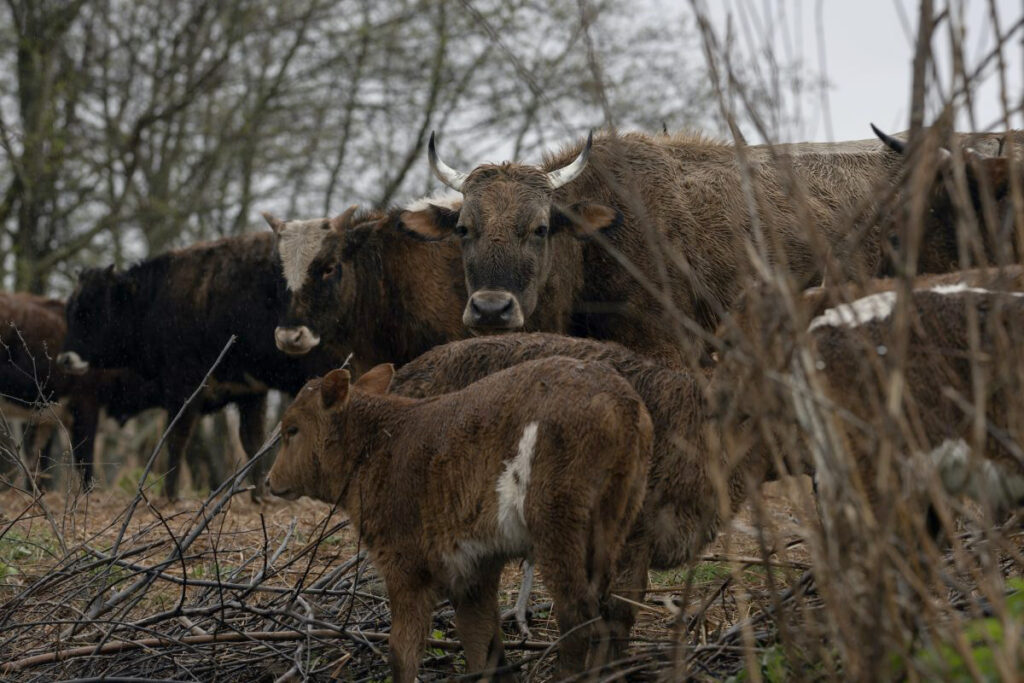
Photo: Andreea Câmpeanu
But the mayor says that in Sfântu Gheorghe animal husbandry is a compromise.
«There are some guys who have taken some land and some cattle […]. Now there are some pastures that are rented, but not many. We have 12 contracts with farmers, covering somewhere between 15 and 70 hectares»– explains the mayor.
Even so, he doesn’t deny that farmers might set fire to clear their pastures.
«Somewhere in the Perișor area, towards Constanța, thousands of hectares burned in the autumn. The leased-out pasture is only 150 hectares. If they wanted to set fire to clear their land, they would set fire to his area and be done with it […]. Burning thousands of hectares and saying you are protecting those 150 hectares doesn’t make sense. But there’s a trend» – confirms Mayor Valentin Sidorencu.

Photo: Andreea Câmpeanu
The Danube delta is a Natura 2000 site, an ecosystem protected at European level. A 2020 EFFIS report shows that Romania is responsible for almost half of the fires that occur within Natura 2000 sites, as a result of fires in this delta. Yet people say that if old vegetation is not cleared, the land can become even more flammable.
«If a fire starts, it spreads much more easily in an area that is not cleared. If the reeds are thick, a fire can jump over the gutter when the wind blows. And then you have no control. On narrow canals, the fire jumps from side to side» – says Nicu Efimov, a fisherman.
And because of the sediment, which has been deposited by vegetation over years, some fires can last for weeks.
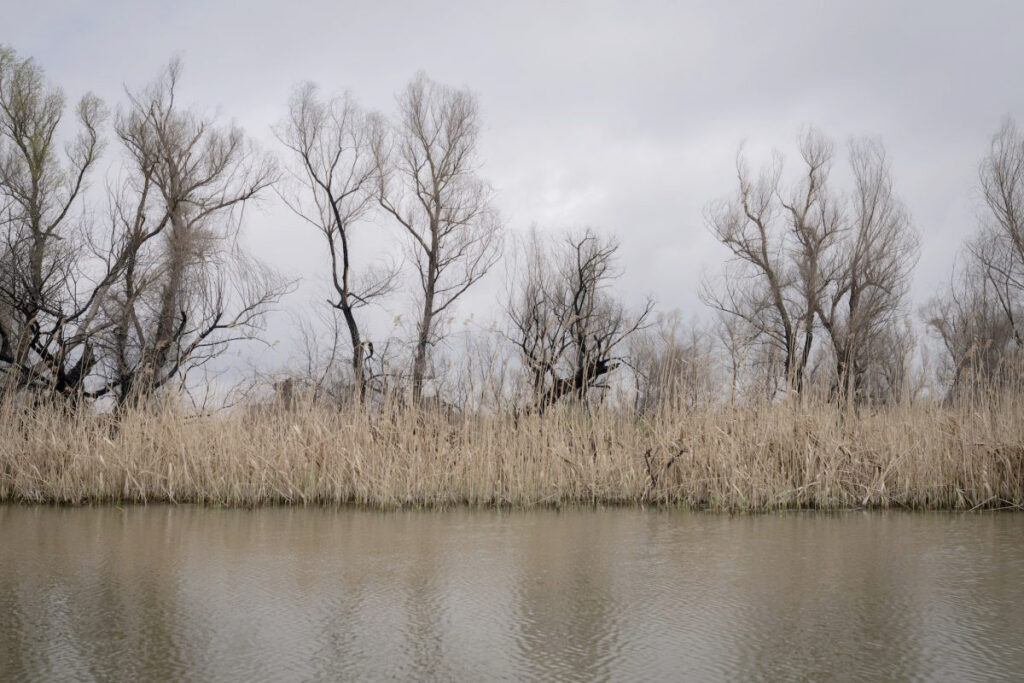
Photo: Andreea Câmpeanu
Mayor: “I don’t intervene if the stubble burns”
The bush has always burned in Sfântu Gheorghe, says the mayor.
«I don’t see a danger apart from the fact that the smoke can be very dense […]. If we are so worried then we should do the analysis. If I don’t harvest the vegetation there, what are the effects? If we don’t burn it, the whole area will atrophy, whole hectares of it» – says Mayor Valentin Sidorencu.
And when it comes to intervening in case of vegetation fires, the mayor says that when the stubble burns, he does not intervene.
«It burns to a crisp. There’s no way to intervene. There were no casualties, there’s just mud. Reeds and more reeds. But it can also get into the adjacent forest area, and that’s where I really see a problem. Otherwise, the vegetation part, you know that I will not intervene» – explains the mayor.
Most bushfires occur in areas that are difficult to access, on water. While waiting for the Tulcea fire brigade to arrive, the Voluntary Emergency Service intervenes. According to the Delta Emergency Inspectorate, there are 49 such services operating in the county.
In Sfântu Gheorghe there are also volunteers who intervene in case of emergency, but not if the stubble is burning.
«When the stubble burns, I don’t go, it’s not my job. I look after my own area. I have a fire engine and I can’t get there. It’s nonsense […]. Technically you couldn’t intervene. If I have wind on the right side, on the left side I have smoke. So I wouldn’t be able to go from the left side, and on the right side there is burnt vegetation so there’s no way you could get access. Only from the air could you intervene» – says the mayor.
The fire “travelled” from Sulina to Sfântu Gheorghe
We saw burnt vegetation on the banks of the Danube. In some areas, the burnt reeds look like a black curtain in front of the forest that is starting to turn green. In other areas, burnt stalks float on the surface of the water, with new vegetation beginning to grow among them.

Photo: Andreea Câmpeanu
Nicolae Acsente has worked in construction in the Netherlands for over five years. We found him at home because the work season abroad has not started yet. He’s out fishing.
Nicu took us on the Danube in the Sfântu Gheorghe area, where in winter the vegetation burned from kilometre 5 to kilometre 17. We stopped in the area where the fire started. Nicolae says it came from Sulina and reached Sfântu Gheorghe.
In the area of kilometre 15 we see a burnt portion, but where vegetation is starting to grow again. Nicolae assures us that in summer it will be full of pristine new reeds.
We continue along the canals, towards the Red Lake. On the left bank, we stop at a clearing where cows have been taken out to graze. In the distance, you can see how the vegetation has burned. The fire has stopped at the edge of the forest, as if there was an invisible barrier there.
On a channel which leads directly into Red Lake, it is obvious that the fire affected both banks.
In the Gherasim Lake area, where the vegetation is much richer in willows and the reeds are missing, there is also a lack of burnt vegetation.
On the opposite side, other opinions
From Tulcea, by dinghy it is a 45-minute ride to Gorgova. This village in Maliuc commune is right on the rocky banks of the Danube, halfway between Tulcea and Sulina. There I met Sorin Condratov, a recreational fisherman who retired to the banks of the Danube after closing his music business and falling in love with the speargun.
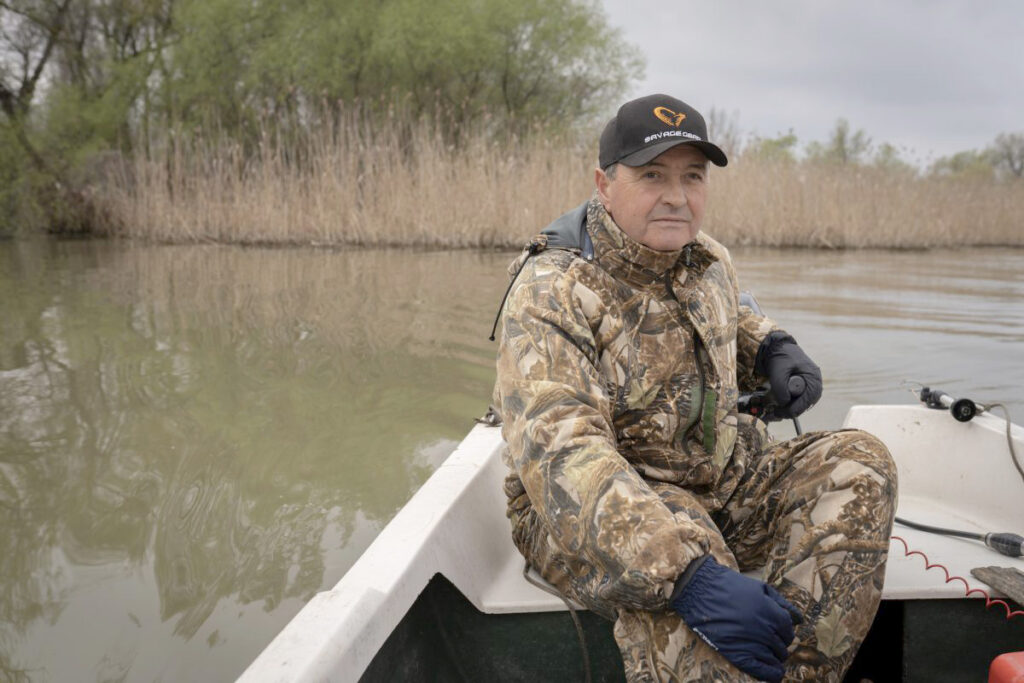
Photo: Andreea Câmpeanu
He says that in the village he is seen as a black sheep, because he comes with different ideas. One, in particular, has to do with the burning of vegetation. Sorin does not think the delta is doing any better since man started exploiting the resources there.
«The formation of the Danube delta over hundreds of years created an exceptional biodiversity. At one point, in the 1950s, we were catching salmon weighing over 400 kg. The variety of plants and animals and fish was extraordinary. After the 1960s and 1970s it went into massive decline. The reasons for this were human intervention: reed farming, fishing, agriculture and livestock farming» – says Sorin Condratov.
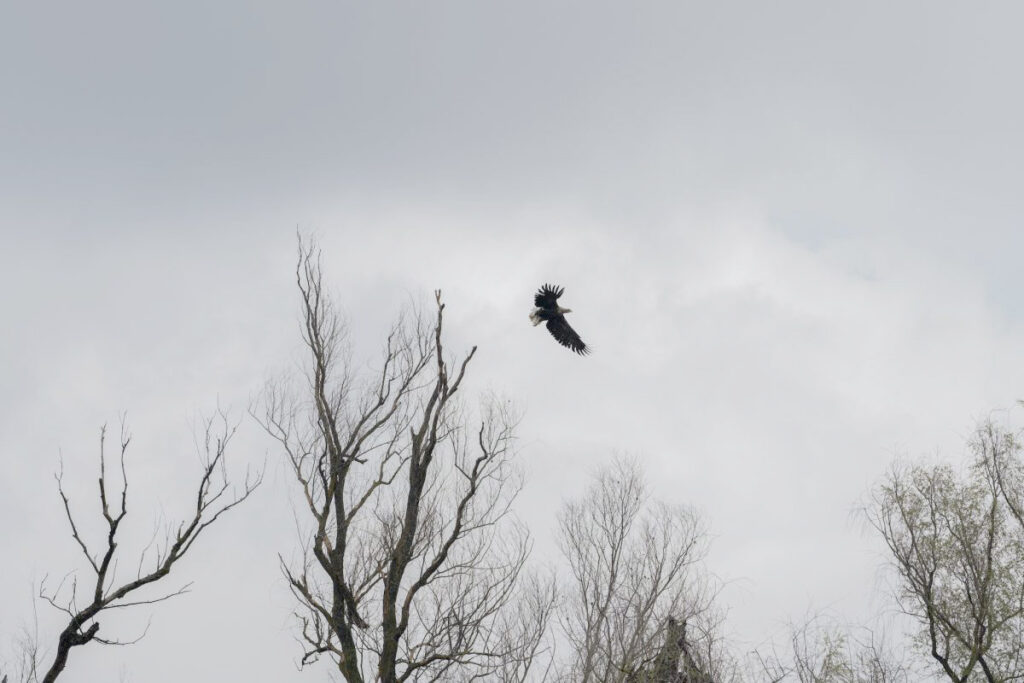
Photo: Andreea Câmpeanu
A recreational fisherman, Sorin believes there is no need for human intervention in the delta. He sees it as a “crime against nature”.
«I can’t understand why they take such pleasure in setting fire to land. They say it regenerates nature, that it gets rid of that mud that gets blown away and spoils the water and that’s why fish don’t reproduce. So how come the water didn’t become foul back then and harm the 400 lb catfish? Around 1900, when the villages came into being, who was burning the land? In that stinking marsh, why did salmon grow to over 400 kg? The carp weighed over 30 kg» – adds Sorin.

Photo: Andreea Câmpeanu
Sorin takes us out on the water by boat. We go to the Olguța Canal, where the bushes burned on both sides a year ago, and then to Lake Furtuna, a legal fishing spot.
There are many historical fishing spots here, such as Șontea Lată. But not all are listed in Annex 3 of the Order of the Minister of Agriculture and Development 159/1266 of June 2011, which specifies the places where recreational fishing is allowed.
Nonetheless, we see a lot of fishermen on our way. “Illegal,” Sorin calls them. He would like to see the law changed in favour of local residents.
We also pass a 5000-year-old archaeological site, Taraschina. The bushfires have been burning there too.
«How green it should be and how black it is in places» – sighs Sorin Condratov.
Reaching the Olguța canal, we see that the fire has burned out and the reeds are starting to regenerate. But that is not true for the trees. The willows, charred from the roots upwards, have not recovered.

Photo: Andreea Câmpeanu
«A year ago it was black on the ground. If after a year not a single green twig has come out of these trees, will anything come out of them? […] My soul is crying inside me. I don’t agree with what they are doing» – concludes Sorin Condratov.
As a recreational fisherman, Sorin is not bothered by reeds. But, when the need arises, even he sets fires. For example, when he wants to harvest reeds to build a fence. But he says everything is kept under control, and that he stays and watches the fire to make sure it doesn’t spread.
«I have no business with reeds. If there’s some I want to take for a fence or for the house, that’s what I burn. Because I can’t harvest fallen reeds. But it’s a strictly controlled perimetre, just for that purpose. Not for regeneration, not for fish, not for any other nonsense» – he says.
Banned in legislation, but accepted and even encouraged in textbooks
Burning herbaceous vegetation is forbidden by law and punishable by fines. But staff managing the Danube delta are taught, via a manual available on the website of the National Research Institute for the Development of the Danube Delta (INCDDD) the following: «In the Danube delta, single-generation reeds are harvested […]. Maintaining single-generation reeds is done by annual harvesting or by burning in winter […]. Burning reeds as an action to clear land covered with multi-generation reeds has a positive effect on land productivity.»

In a press release sent to PressOne, INCDDD representatives explained the effects a vegetation fire can have on flora and fauna. The ideas are identical to those in the manual presented above, which was written in 2013.
«It was found that there is a low impact of fire on annual plant species in the [delta] area. For example, reed burns practised as a clearing action on land covered with reeds for several generations have a positive effect on land productivity and mechanised harvesting conditions».
In the same press release, INCDDD says that the effects on invertebrates are insignificant because “populations suppressed by fire” are in larval form. But the same is not true for reptiles: land tortoises often fall victim to fires. Birds are also affected, as to burn reed beds for more than two consecutive years can reduce bird numbers by up to 60%. Small mammals such as the European mink, which live in reed beds all year round, are also at risk.
INCDDD’s conclusion? «As you can see, there are both positive and negative effects».

Photo: Andreea Câmpeanu
“If you don’t listen to me, why should I listen to you?”
The mayor of Sfântu Gheorghe, Valentin Sidorencu, argues that intervention is needed to clean up the reeds.
«I couldn’t say that I’m encouraging citizens, because it’s illegal, and I won’t make it a priority. But I’m not convinced that it should be banned 100%. And I’ll tell you why: we’re not a partner in this reservation business. The state has not been one either. […] We have created some restrictive measures, but we have not enforced anything. What did the state do after banning fires? A little understanding is needed for our side as well. Show me where I’m wrong, let’s find each other, explain where we’re wrong. If they set a fire in February, explain to me why it’s wrong» – says the mayor.

Photo: Andreea Câmpeanu
From talking to people, it is easy to see that the problems in the Danube Delta Biosphere Reserve are not just the stark numbers on the fire map. They stem primarily from poor cooperation with the reserve’s administration.
Edi Acsente, a tour guide in Sfântu Gheorghe, says one problem is that the reserve’s administrators have forgotten that people live in the delta.
«Unfortunately, the [reserve] leaders consider the inhabitants of the Danube delta as parasites. In every respect. They don’t belong there. You’d like them to disappear and there to be only animals. Like a living aquarium, like a living museum. Surrounded by glass from top to bottom so one can see how an otter moves, how a bird flies» – says Edi Acsente.
People feel they have no say in how the delta is run and, consequently, no say in their lives.
«For example, according to the regulations, for any economic or industrial activity that you prohibit on the territory of the reserve, for whatever reason, you have to compensate the inhabitants. The Romanian state banned sturgeon fishing, but without giving any compensation. It had been a fantastic source of income. Everything that happens, happens as a backlash. If you don’t listen to me, why should I listen to you?» – says Edi Acsente.
From September to November 2022, the reserve administration carried out a series of public consultations with local communities to collect their suggestions on the measures envisaged in the new Danube delta management plan.
In a press release issued to PressOne, people’s demands are clear. Their demands include a compensation for fishermen, better communication with the local population, and an increasing control to catch and sanction those who put the vegetation on fire.
That the reality of the Danube delta is not properly understood by the reserve’s administrators is exemplified by the fact that in 2008, the state issued a government decision that all houses in the delta should be covered only with reeds or tiles. But many houses are made of clay or wood and cannot withstand the pressure of a reed roof. A house may collapse with such a roof.
The poor working relationship with the reserve administrators stems from the fact that they have taken on more than they can handle, says the mayor.
“The area is very large, around 580,000 hectares. They have established a very large protected area and they can’t manage it. In Sfântu Gheorghe, half of the area is strictly protected» – says Mayor Valentin Sidorencu.
One problem remains the non-use of the reeds. There used to be a pulp mill in Braila where reeds were processed. Now, not only does the reed remain on the marsh, but even if you want to harvest it for roofing, for example, the high-quality reed is in strictly protected areas, where one cannot enter.
Burning without consequence
Vegetation is often burned almost thoughtlessly. Decisions are taken by individuals, even passers-by.
Legal consequences are almost non-existent. According to the mayor, it is impossible for the police to intervene in time to catch a perpetrator in action, given that the municipality covers 62,000 hectares. In the period 2020-2023, the Danube Delta Biosphere Reserve Administration applied 8 fines, each of 400 lei (€81). For context, in 2020 a total of 177 vegetation fires were recorded.
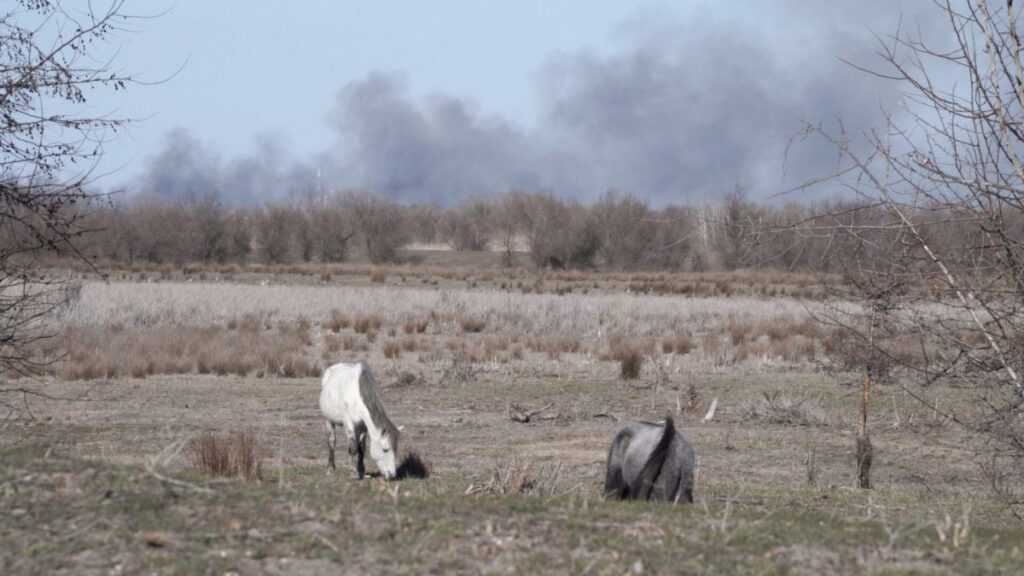
Photo: Octavian Coman
Romania’s Agency for Payments and Intervention in Agriculture can impose sanctions. It can withdraw payments from farmers who burn their land, but only if that land is declared as being in agricultural use and registered to receive European Union funds. Between 2020 and 2023, this was done for an area of just 12.53 hectares across the whole of Tulcea County, which covers more than the Danube delta.
The delta is no longer as rich as we imagine
Mrs Ionela, a housewife, drives tourists around in her green tuk-tuk in the summer and fishes with her rod and float behind her house. In her view, the richness of the delta is now an illusion.
«It’s an impoverished delta, it’s not the delta it once was. There are no more fish. Now it’s the scabbard fish season, but in the summer you have to hunt like crazy to catch a fish to make a meal» – says Mrs Ionela.

Photo: Andreea Câmpeanu
The reality of the Danube delta is different from the legislation that should protect it. Poor cooperation between the competent authorities and the local community keeps the fire problem unresolved. Meanwhile, every year, the delta catches fire. And every year, the blame is passed from one camp to another.
Without concrete solutions, without alternatives when something is prohibited, and without knowledge of the resources and tools available to the local people, this situation is likely to endure for a long time to come.

Photo: Andreea Câmpeanu
Most of the inhabitants of Sfântu Gheorghe are over 50. But grandchildren from the city still come to visit their grandparents. On a spring evening in Sfântu Gheorghe, a grandmother keeps her grandson company.
«It’s the sea talking, do you hear?» – asks the grandmother. «What is the sea talking about?»– asks the grandson.
It would not hurt to start listening to what the Danube delta is saying. And to listen to all its inhabitants. They too are part of the Danube Delta Biosphere Reserve.
Saturday, 24 June 2023
On the cover: photo by ©reginastupului74/Shutterstock
Original source: EDJNet – The European Data Journalism Network – https://pressone.ro/romania-arde-i-cum-a-ajuns-focul-sa-puna-delta-dunarii-pe-harta-incendiilor-de-vegetatie-din-europa-care-trece-cu-barca-si-i-se-pare-ca-e-prea-mult-stuf-ii-da-foc/ – CC 4.0 International (CC BY 4.0)

